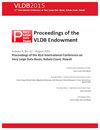FastMosaic的实际应用:用于数组dbms的一种新的马赛克运算符
IF 3.3
3区 计算机科学
Q2 COMPUTER SCIENCE, INFORMATION SYSTEMS
引用次数: 0
摘要
Array dbms对N -d阵列进行操作。在数据摄取阶段,广泛使用的马赛克运算符将大量重叠数组的集合摄取到单个大数组中,称为马赛克。操作员可以利用复杂的统计和机器学习技术,例如典型相关分析(CCA),产生高质量的无缝马赛克,其中从输入重叠阵列中获取的单元值之间的对比度最小。然而,当将这种先进技术应用于日益增长的阵列体积时,性能瓶颈成为一个主要挑战。我们引入了一种新的、可扩展的方式来执行CCA,它比流行的Python scikit-learn库要快几个数量级,用于数组拼接。此外,我们还开发了一个混合网络桌面应用程序,以展示基于这种新的CCA的新型FastMosaic操作器。丰富的GUI使用户能够全面地研究输入/输出数组,使用FastMosaic交互式地指导在现实世界的地理空间数组上进行端到端拼接构建,从而方便地探索FastMosaic管道及其内部。本文章由计算机程序翻译,如有差异,请以英文原文为准。
FastMosaic in Action: A New Mosaic Operator for Array DBMSs
Array DBMSs operate on N -d arrays. During the Data Ingestion phase, the widely used mosaic operator ingests a massive collection of overlapping arrays into a single large array, called mosaic. The operator can utilize sophisticated statistical and machine learning techniques, e.g. Canonical Correlation Analysis (CCA), to produce a high quality seamless mosaic where the contrasts between the values of cells taken from input overlapping arrays are minimized. However, the performance bottleneck becomes a major challenge when applying such advanced techniques over increasingly growing array volumes. We introduce a new, scalable way to perform CCA that is orders of magnitude faster than the popular Python's scikit-learn library for the purpose of array mosaicking. Furthermore, we developed a hybrid web-desktop application to showcase our novel FastMosaic operator, based on this new CCA. A rich GUI enables users to comprehensively investigate in/out arrays, interactively guides through an end-to-end mosaic construction on real-world geospatial arrays using FastMosaic, facilitating a convenient exploration of the FastMosaic pipeline and its internals.
求助全文
通过发布文献求助,成功后即可免费获取论文全文。
去求助
来源期刊

Proceedings of the Vldb Endowment
Computer Science-General Computer Science
CiteScore
7.70
自引率
0.00%
发文量
95
期刊介绍:
The Proceedings of the VLDB (PVLDB) welcomes original research papers on a broad range of research topics related to all aspects of data management, where systems issues play a significant role, such as data management system technology and information management infrastructures, including their very large scale of experimentation, novel architectures, and demanding applications as well as their underpinning theory. The scope of a submission for PVLDB is also described by the subject areas given below. Moreover, the scope of PVLDB is restricted to scientific areas that are covered by the combined expertise on the submission’s topic of the journal’s editorial board. Finally, the submission’s contributions should build on work already published in data management outlets, e.g., PVLDB, VLDBJ, ACM SIGMOD, IEEE ICDE, EDBT, ACM TODS, IEEE TKDE, and go beyond a syntactic citation.
 求助内容:
求助内容: 应助结果提醒方式:
应助结果提醒方式:


